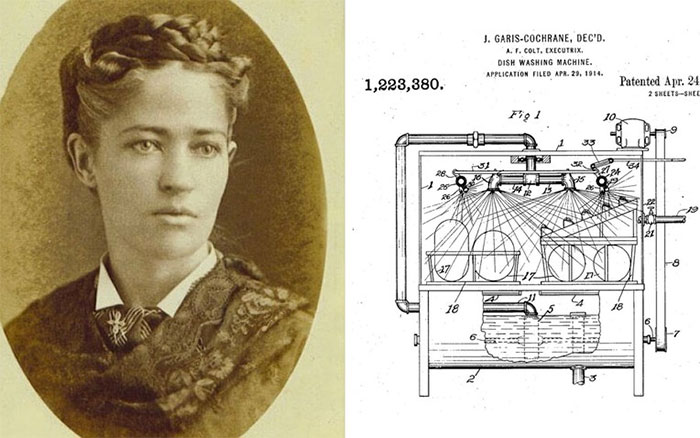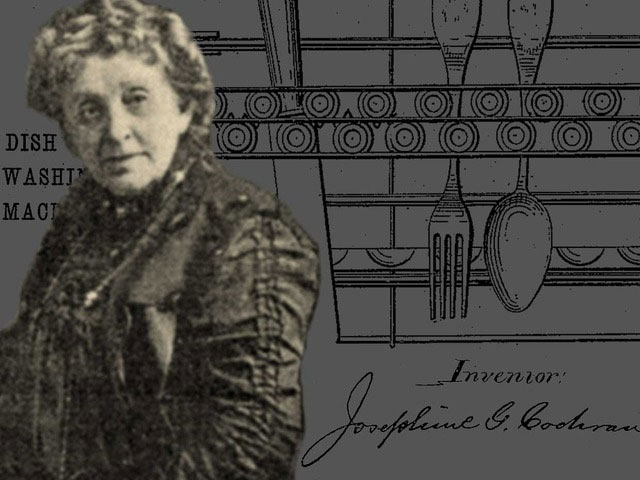Who invented the dishwasher?
In the 1880s, Josephine Garis Cochran changed the way people washed dishes when she invented the first modern dishwasher . Unlike previous devices, Cochran's invention cleaned dishes using water pressure, which was more efficient and opened a new page in the field of household appliances.
Josephine Garis Cochran is a little-known name, but her invention in the 1880s forever changed the way we wash dishes and paved the way for the modern home appliance industry. Not only was she a talented inventor, but Cochran also demonstrated business, manufacturing, and marketing skills that helped her overcome challenges and create a lasting legacy.

Josephine Garis Cochran and the design of the dishwasher.
Born around 1839-1841 in Ashtabula County, Ohio, Josephine Garis grew up in a family with a long tradition of engineering. Her father was a civil engineer who worked on complex machinery in factories and pumping systems. So perhaps this family background had a big influence on Cochran, even though she had no formal mechanical training.
She married William Apperson Cochran in 1858, settled with him in Shelbyville, Illinois, and had a quiet family life. However, her husband's sudden death in 1883 left her with considerable debt. To overcome her difficulties and find a way to support herself, Cochran began thinking about creating a machine that could ease the burden of household chores - the dishwasher.

Cochran wanted to create a machine that used high water pressure to blast away dirt.
At the time, washing dishes was a time-consuming and laborious task, especially for wealthy families who owned many precious ceramic dishes. Cochran realized that previous dishwasher designs relied on scrubbing with a brush, which made them difficult to clean thoroughly. But Cochran's idea was different: instead of using a brush, she wanted to create a machine that used high-pressure water to blast away dirt and debris from dishes.
With no formal engineering education, Cochran sought help from a mechanic named George Butters. Together, the two built their first machine, a simple but efficient brass device. She figured out how to create separate racks for each dish to prevent it from being knocked over and chipped during the wash. In 1886, Cochran officially received a patent for her invention from the United States Patent and Trademark Office, marking the birth of the first dishwasher.

Her products are difficult to reach many families because of the high price.
After obtaining her patent, Cochran began manufacturing and selling dishwashers. However, because the market was unfamiliar with the new device and the high price (up to several hundred dollars at the time), her product was not accessible to many families. Most ordinary families did not have hot water systems, a requirement for Cochran's dishwasher. For wealthy families, her product was a luxury. Therefore, Cochran focused on selling her product to businesses such as hotels and restaurants, where efficiency and time savings in cleaning were needed.
To ensure quality and not rely on other manufacturers, Cochran decided to open her own factory, with George Butters as her foreman. At this factory, she encountered many technical challenges and even faced disrespect from her male employees. In a 1912 interview with the Chicago Record-Herald , Cochran shared that employees often did not follow her instructions because they thought she had no mechanical knowledge. It took a lot of time and effort for Cochran to prove that her design and methods were correct, making the dishwasher more efficient.

Cochran decided to open his own factory so he wouldn't have to depend on anyone.
Cochran was not only an inventor, but also a talented marketer. In interviews, she often portrayed herself as a wealthy woman who invented the dishwasher because she was tired of having her servants chipping her precious china. However, census records show that she did not actually have many servants, and the story of her wealthy background may have been a publicity stunt to create hype for her product. Cochran also encouraged the press to believe that she was the granddaughter of John Fitch, the inventor of the steamboat. Although she knew this was not true, she gave this impression to increase her credibility and public interest.

Cochran is constantly improving the design and functionality of dishwashers.
Despite the marketing stories, Cochran was a talented and persistent woman. She did not stop at inventing, but actually participated in manufacturing, selling, and supervising the installation process. Cochran continued to improve the design and functionality of dishwashers, constantly filing patents for new improvements that increased efficiency and quality.
In 1890, Cochran moved to Chicago and introduced her dishwasher at the World's Columbian Exposition in 1893. This event opened a new chapter for her as she won awards for her invention. Cochran continued to promote and exhibit her dishwasher at major fairs in Massachusetts, New York, and Missouri, where her product attracted the attention of the business community and the public.
After Cochran died in 1913 in Chicago, her company was sold and later incorporated into the KitchenAid brand, marking a new phase of development for dishwashers. It wasn't until the 1950s and 1960s, when hot water systems became more common, that dishwashers truly became common household appliances.
- Video: How does the dishwasher work?
- The old man invented the washing machine
- Video of dishwasher operation
- Dishwasher uses solar energy
- Solar dishwasher by Tay Nguyen teachers
- British scientist introduces dishwashing robot
- who invented the flexible wetsuit?
- 11 inventions were born early but until now it has been popular
- Outstanding inventions in 2006
- Invented waterproof fabric
- Invented a new fabric that can 'hear' sound
- Denmark invented self-rehabilitation computer
 The most famous scientific failures in history
The most famous scientific failures in history Mysterious genius mechanic and the machine froze time
Mysterious genius mechanic and the machine froze time The son carries the 'bad gene' of genius Albert Einstein
The son carries the 'bad gene' of genius Albert Einstein Isaac Newton
Isaac Newton